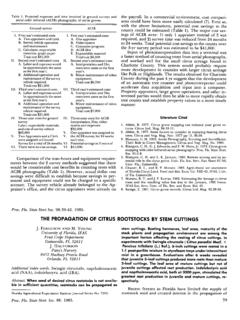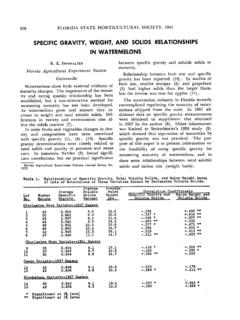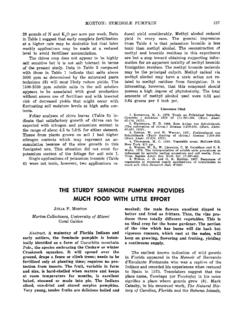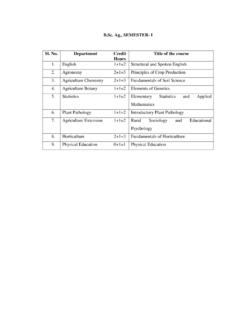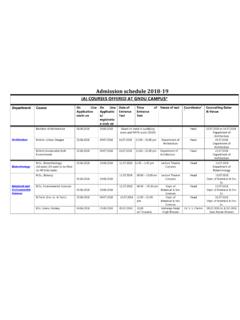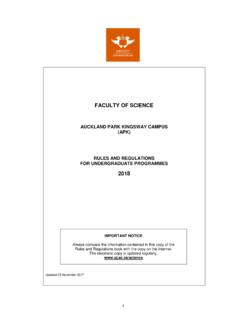Transcription of THE BOTANY OF THE CITRUS FRUITS AND THEIR WILD …
1 156 FLORIDA STATE HORTICULTURAL SOCIETY. THE BOTANY OF THE CITRUS FRUITS AND. THEIR WILD RELATIVES AS A GUIDE. TO THEIR USE IN BREEDING. WALTER T. SWINGLE. Collaborator9 U. S. department of Agriculture Fifty years ago, in April, 1893, I read fungicides in Europe, with salary but with a paper before the 4th Annual Meeting of no expense money of any kind. 1/. the Florida State Horticultural Society giv By July 1, 1899, the Plant Introduction ing a list of a number of CITRUS FRUITS not Service was established in the department yet grown in this country, and suggesting of Agriculture by David Fairchild. Both the organization of a non-profit stock com he and I were commissioned as Agricultural pany to introduce new CITRUS FRUITS from Explorers and sent at once to foreign re the Old World.
2 I expected at best a few gions, he to the East Indies, and I to the words of thanks for my paper and was countries bordering the Mediterranean. From greatly surprised to "see the leading orange that day to this a stream of CITRUS varieties growers of Florida (there were no grape and CITRUS wild relatives has been entering fruit growers then) get up, one after an this' country from all the warmer regions other, and give THEIR warm approval to the of the world. project. Finally by a unanimous vote of the Dr. Fairchild, Dr. Webber, Prof. G. W. Society, a committee was appointed to or Groff and I, all members of the Florida State ganize such a CITRUS introduction company. Horticultural Society and the Krome Insti While this committee still had the matter tute, have all of us worked in season and under consideration the two great freezes out to secure new CITRUS FRUITS for this of December, 1894, and February, 1895, country.
3 Having lost during the great freezes killed to the ground all the CITRUS trees in of 1894 and '95, all of the many CITRUS the commercial groves and it was, of course, hybrids I had made in 1893, I determined impossible to consider going ahead with the to get a Subtropical Station in the. Miami Pensacola project. However, the great interest shown by the 1/ In April, 1899, I made the first suc leading orange growers of Florida convinced cessful shipment of the fig wasp ( Blast o- Dr. Herbert J. TjTebber, Dr. David Fairchild phaga psenes) which breeds in the FRUITS and me that somehow this work of intro of the male fig trees (or caprifigs) and ducing Old World CITRUS varieties and wild carries pollen to the young flowers of relatives should be undertaken as soon as the best varieties of figs used for drying.
4 Possible, if practicable by the U. S. Per This shipment reached America too late partment of Agriculture if authority could to get established in caprifig trees grow be secured to spend money abroad. ing in Fresno, California, but a ship In 1894 Dr. David Fairchild studied Citron ment I made from Algiers in March, culture in Corsica and introduced into this 1899, arrived in Fresno on time, and country the famous Corsican citron. In 1898 by October 1899 was well established. I sent to Washington from Naples, Italy, This introduction of the fig. wasp made the other important citron variety grown possible the growing in California of in Italy, the Liscio or Diamante citron. This dried figs of the Smyrna type to the ex I did while on my way to work on copper tent of 10-12 thousand tons annually.
5 FLORIDA STATE HORTICULTURAL SOCIETY 1S7. region where young hybrids and delicate Lingnan University, Kwok Wah-Shou, the tropical CITRUS relatives could be grown son of a CITRUS grower, worked for me un safely. Thanks to the efforts of Mr. Ingra- der the immediate supervision of Prof. G. ham, his chief, Mr. Flagler approved the W. Groff for two years on the varieties of plan, and the Florida East Coast Railway CITRUS grown around Canton, China. He de allowed me to select a tract now in the city scribed and figured about one hundred varie of Miami, and it was placed at our disposal. ties, mostly oranges and pummelos. CITRUS A legal technicality prevented the U. S. De is grown in almost all the lowlands in the partment of Agriculture from accepting the south' half of China, an area about the size deeds tendered to them and finally this of all of the United States south of the property had to be vacated.
6 Dr. David Fair- Potomac, Ohio, Missouri and Kansas Rivers! child thereupon leased properties north of CITRUS trees have been grown in many parts the Miami River, which some years later of China for three or four thousand years had to be given up. Due to the tireless ef and innumerable seedlings have arisen in forts, a permanent Plant Introduction Gar- dooryard or village groves. A few of them den was finally established at Chapman have been proved to be new and superior Field and for many years rare CITRUS fruit sorts, some of them complex hybrids made trees and related trees have been growing through cross pollinations effected by bees vigorously there. or other insects. Undoubtedly a thousand Thanks to this succession of Federal Sub or more varieties and strains of CITRUS tropical Gardens, to the Florida State Uni fruit trees are now grown in China and versity's Subtropical Station at Homestead, many hundreds more in Indochina and In and to private gardens like Dr.
7 Fairchild's dia, where also CITRUS culture is an ancient Kampong, and Col. Montgomery's Arboret art. Here is to be found the richest store um, it has been possible for nearly half of CITRUS varieties in the world, at least a century to grow to full maturity in the ten times as many as we know in this continental United States all the many tropi country. cal relatives of CITRUS that have so far been The large importations- of CITRUS plants introduced. from Asiatic regions liable to carry CITRUS During the campaign for eradication of canker, to say nothing of diseases and in CITRUS canker, an appropriation was made sects as yet unknown in New World, nec to the Bureau of Plant Industry in 1915 essitated the creation by Mr.
8 T. Ralph Rob to enable a search to be made for canker- inson, Eugene May and myself of a system resistant CITRUS varieties. These funds per which we called aseptic plant propagation mitted me to undertake an exploration of (Dept. Agric. Circular 299 (1923)) 1/ to the southeastern Asiatic region, China, In prevent any risk of introducing diseases or dochina, Thailand, ths Philippines and Jap pests, and at the same time secure vigorous, an to find canker-resistant varieties and to healthy propagation of all the numerous establish a field station in the Philippines species and varieties introduced from the to test the resistance of all obtainable Cit home of oranges, kumquats, and pummelos rus varieties to CITRUS canker.
9 This work in S. E. Asia and the adjacent islands. continued nearly two decades and resulted 1/ All of the papers mentioned here and in the discovery, description, and illustration very many others on the introduction of a vast number of CITRUS varieties and of CITRUS fruit trees, and THEIR use for also canker-resistant wild relatives of Cit rootstocks or for -hybridizing are cited rus. Many of these had never before been in full in the bibliography of the first seen by the orange growers of Europe or of volume of "The CITRUS Industry*' now the New World. being printed at the University of Cali A talented young Chinese graduate of fornia Press, Berkeley, California. 158 FLORIDA STATE HORTICULTURAL SOCIETY.
10 Because of the long continued effort to we now know that there is every reason carry out the project approved at Pensacola to expect very great progress to be made half-a-century ago, we now have growing in improving rootstocks by hybridizing^ Cit in Florida more species and varieties of rus with' other related genera such as Pon- CITRUS and related plants of the orange cirus, Fortunella, Microcitrus, Eremocitrus subfamily than are found in cultivation in and probably others not yet available for any Old World country! r trial. As soon as possible after the great freeze As soon as it became evident that CITRUS of 1894 and '95, I made a number of hy could be hybridized with some of the related brids and originated the first Citranges and genera, even with some that looked very Tangelos, which, when they fruited, were unlike CITRUS , I began to study the BOTANY described and figured by Dr.

